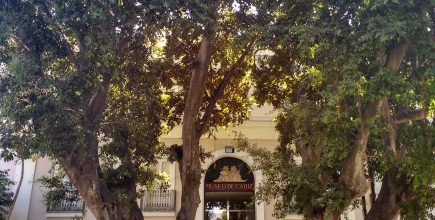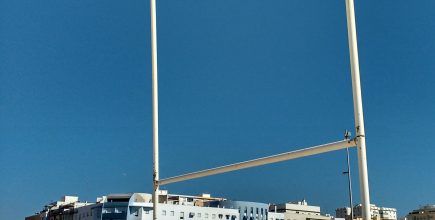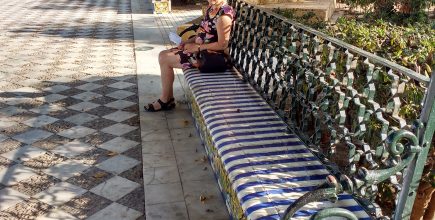One of my "Tribute to Europe" travel articles I'm publishing in January 2020
Cádiz, ancient and sparkling city surrounded by sea in the far south west of Spain.
Cádiz, the ancient and sparkling city surrounded by sea in the far south west of Spain, and now a popular port of call for cruise ships, has been one of the under-rated wonders of Europe. But that is changing. The New York Times placed it on its 52 Places to Visit list for 2019. ‘The city…has a vibe that’s more Havana than Madrid.” It notes “a culinary renaissance”, and extols ‘the hot list of sommeliers and the craft-cocktail crowd” in Jerez de la Frontera.
My list of highlights includes the second biggest Roman theatre, rare Phoenician figures, a beach fit for a Bond heroine’s entrance and fabulous tapas.
High-speed trains serve Cadiz from Madrid, with connections from Barcelona, then Paris and London. See details on getting there by rail below.
Jerez Airport is a short rail trip away. (At the station, opt for the ticket machine for the fast, slightly dearer, Renfe train, not the slower one.)
The city, compact and ancient on a thin peninsula on the far south-west of Spain, grew rich as the hub of Spain’s trade with the Americas. It has been spared mass tourism over the years, and its 18th-century layout remains intact.
The old heart of Cadiz is a colourful maze of narrow canyon-like streets, peppered with little shops, cafés and restaurants. They have names such as Trinidad, San Francisco, Sacramento, Paraguay, and of course Cristobal Colon (Columbus), who began two voyages here. You can still see ancient metal casings, which once protected buildings at junctions from heavy carts. The sun floods 11 leafy squares, plazas, of varying size, each with a fact-filled interpretation board and suggested walks. At weekends the streets and squares buzz and bustle late into the night, full with families and raucous parakeets.
We stayed in an Airbnb in the historic heart. The only night-time sound came from ancient church clocks.
See and do
To Cadiz by train
Has to be two days, unfortunately, even from London. But stay overnight in Barcelona.
To Cadiz by train
Day 1, London to Barcelona.
Depart London St Pancras 10:24 (Eurostar to Paris Nord), then TGV from Paris Gare de Lyon to Barcelona Sants, arr 21:46.
Stay overnight in Barcelona.
Day 2.
Depart Barcelona 08:30, and arr Cadiz at 16:27.
Return.
Dep Cadiz 12:40, change at Seville, arr Barcelona Sants 20:22.
Overnight in Barcelona.
Day 2.
Barcelona Sants 10:10 to Paris Gare de Lyon, then Eurostar from Paris Gare du Nord to London St Pancras arriving 20:46.
https://www.seat61.com
Car dire
If you only stay a few days, there’s no reason to hire a car in Cadiz. Nowhere in the Andalusian city is more than a short step from the water, in any direction. There is a great ocean-side walk (or cycle) from the Puerta de Tierra gate. It runs the length of the Campo del Sur promenade, past the cathedral to La Caleta beach. Halle Berry emerges from the waves here in Bond movie Die Another Day, with Cadiz standing in for Havana in Cuba. (Quilla las Caletas is a good open air bar.) The road curves on around the headland (with views across the bay to Portugal), past the botanical garden and its noble old trees. There are abundant miles of clean holiday sand just east of the old town, an easy walk away.
Sensational stones
Remember those human-shaped coffins that contain the frozen spacemen in the movie 2001? There is a pair of rare Phoenician sarcophagi, on proud display in Cádiz Museum, that look just like them. The first, of a man, was found in 1887, on the site of the Cadiz shipyard. They unearthed the second, of a woman, as recently as 1980. Only ten such sarcophagi have been found to date. Complementing them are recent paintings by two contemporary Spanish artists, showing the couple as they might have have been in life. This cool, light building is worth another visit (it’s free, but only for EU citizens), for the small but seriously good display of paintings, which includes an early Rubens and some high-class works by Spanish artists Murillo and Zurbarán (called the Spanish Caravaggio for his use of chiaroscuro).
Marble Marvel
Catedral Nueva is the city’s finest building, dominating the main square. Completed in 1838, the cathedral, in plain white marble, was part funded by the city’s trading riches. The voice on our audio guide sounded like (but wasn’t) Jeremy Clarkson. His cheery tones led us through the nave, bathed in sunlight, to an astonishing silver monstrance, a massive box carried in solemn processions. In a quiet corner of the crypt, beneath the level of the nearby sea, blissfully cool on a hot day, is the grave of Cádiz-born composer Manual de Falla, who wrote El Amor Brujo.
King of Spain's beard
History is piled high in Cadiz, from the founding Phoenicians, 3000 years ago, and on down long ages. Sir Francis Drake has a brief starring role, “singeing the King of Spain’s beard” in the 1587 attack on his navy in the Bay of Cádiz. The observations towers (Torre Tavira is the highest, in the old town), recall the days when merchants scanned the horizon for their argosies returning, laden with riches, from the Americas. The discovery of the long forgotten and largely intact Roman theatre in 1980 was the latest bonus. This spectacular edifice held 20,000 spectators, and is one of the largest in the Roman empire. There’s a riveting accompanying museum. The city’s market is built on the Roman original, while the museum displays some fine Roman remains, a statue of Trajan, and heads of Germanicus, Drusus and Livia.
Haydn's Good Friday commission
The other religious building of note is the Oratorio Santa Cueva, the Holy Cave. Paintings by Goya shine out in this Baroque gem, unchanged since it was built in 1783. A sacred string quartet by Joseph Haydn, based on a piece commissioned for this church, plays on a continuous loop.
The Oratorio consists of two chapels: the low chapel dedicated to the Passion and the high one to the Holy Sacrament. It is considered to be one of the finest monuments of Spanish art, and the high point of the neo-classical style in Cadiz.
As for Haydn’s “The Seven Last Words of Our Saviour on the Cross”, written for Holy Week, the composer himself considered it one of his most successful scores.
The work’s origins were in earthquakes in Peru in 1687. A Jesuit priest there introduced, as a response to the disaster, a Good Friday devotion based on the seven utterances that the Gospels say Jesus made from the cross.
This new devotional service was picked up from colonial Peru and taken to Spain, originally in the seaport of Cádiz. In 1786 city clergy commissioned Haydn to write music based on the words of Jesus.
The original commission to Haydn was for an orchestral piece, interspersed with readings from the Bible and priestly meditations. It was to be performed, in 1786, at the Good Friday service at the Oratorio de la Santa Cueva.
Haydn later explained the challenge he faced as a composer.
“It was customary [in Cádiz] to produce an oratorio every year during Lent, the effect of the performance being not a little enhanced by the following circumstances. The walls, windows, and pillars of the church were hung with black cloth, and only one large lamp hanging from the center of the roof broke the solemn darkness.
“At midday, the doors were closed and the ceremony began. After a short service the bishop ascended the pulpit, pronounced the first of the seven words (or sentences) and delivered a discourse thereon. This ended, he left the pulpit and fell to his knees before the altar. The interval was filled by music. The bishop then in like manner pronounced the second word, then the third, and so on, the orchestra following on the conclusion of each discourse. My composition was subject to these conditions, and it was no easy task to compose seven adagios lasting ten minutes each, and to succeed one another without fatiguing the listeners….”
The priest who commissioned the work, Don José Sáenz de Santa María, is said to have paid Haydn by sending the composer a cake. Haydn discovered it was filled with gold coins.
This original orchestral version remains the least known of all. It was published in 1787 and then performed in Paris, Berlin and Vienna. In 1787 Haydn adapted it for string quartet (the version you will hear on a continuous loop in the church today, and the one performed most widely these days) and in 1796 as an oratorio (with soloists and a choir). This version of the Seven Last Words was a favourite among Victorian and Edwardian choral societies. It has been described as the composer’s Haydn’s most neglected choral masterpiece. Haydn also approved a version for solo piano.
The work has nine movements. Seven “sonatas”— slow meditative sections, some of them very bleak —are bookended by a slow introduction and the piece’s conclusion, depicts the earthquake that the Gospels describe as marking the death of Jesus. (Might it also be a nod to the Peruvian earthquake?) This makes a spectacular effect in some recorded versions. (The seven sections are: “Father, forgive them, for they know not what they do.” “Surely, I say to you, today you will be with me in paradise.” “Woman, behold your son! Behold your mother!” “My God, my God, why have you forsaken me?” “I thirst.” “It is finished!” “Father, into your hands I commend my spirit.”)
In the 19th century, the Good Friday Three Hours Devotion was taken up in Protestant churches. The “Last Words” entered the concert repertory.
Today it may commonly be heard during Holy Week not as a straight concert performance, but interspersed with speakers delivering meditations on each of Jesus’ utterances.
03 Places to stay and eat
Eating out is a simple delight in Cadiz. (I recommend all the following). It starts with breakfast. Maybe an open sandwich of ham, egg and tomato, with café con leche, in Calle Santa Ines, outside the church of San Felipe Neri, the site of the first Parliament. Or in the elegant newly-restored Café Royalty, classical, elegant and decadent, one of the landmark cafes of Europe. Lunch can be a random choice of fabulous tapas or main dishes at outdoor places – Meson la Cartuja (for gazpacho, sardines and paella), or Freduria Las Flores (dogfish and the local prawns), next to the market. In the evening we perched on an outside table in Mesón Cumbres Mayores, above the polished stones of Calle Zorrilla, eating cheese and the finest ham, with sherry from Jerez, watching the paseo, the evening procession.
04 Nearby
A possible visit to a sherry producer.
The New York Times, in its 2019 52 Places citation, proposes:
“Beyond the cities, hilltop white villages like Vejer de la Frontera lure expats with a blend of hip luxury hotels and art by the likes of Olafur Eliasson at NMAC sculpture garden. Add a stretch of Atlantic shore, and the province of Cádiz ticks all the boxes.”



